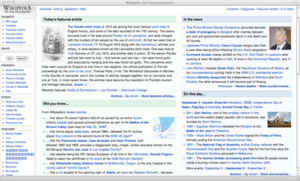Fluid (web browser)
Fluid is a WebKit2-based site-specific browser (SSB) for Mac OS X created by Todd Ditchendorf.[2][3] Its original WebKit-based version was compared to Mozilla Prism and mentioned in Lifehacker,[4] TechCrunch,[5][6][7] 43 Folders,[8] the 37 Signals blog,[9] and on InfoWorld[10] as a way to make web applications more like native desktop applications.
 | |
 The English Wikipedia website displayed in a minimalist -configured site-specific browser window created by Fluid. | |
| Original author(s) | Todd Ditchendorf |
|---|---|
| Initial release | December 9, 2007[1] |
| Written in | Objective-C |
| Operating system | Mac OS X |
| Platform | WebKit, Cocoa |
| Type | Site-specific browser |
| License | Proprietary freeware with open-source components |
| Website | fluidapp |
Open-sourcing
On March 18, 2010, Fluid developer Todd Ditchendorf announced on his weblog that he was open-sourcing the browser-portion of Fluid (also used by the Cruz browser) under the Apache License as Fluidium.[11]
On June 7, 2010, Todd Ditchendorf also open-sourced the "SSB creator" portion of Fluid, also known as Fluid.app.[12]
1.0 milestone
On May 1, 2011, Fluid 1.0 was released with a completely new codebase. Fluid Apps created with previous versions of Fluid cannot be updated via software update and SSBs have to be re-created with Fluid 1.0 (to transition to version 1.0 and later).[13] While version 1.0 is still a free app, a Fluid License can be purchased which will unlock extra features (some previously included by default in previous versions). On July 4, 2011, version 1.2 was released and featured compatibility with Mac OS X 10.7 Lion.[14]
2.0 milestone
In July 2018, Fluid underwent another rewrite[15] to take advantage of Apple's newer WebKit2 API with process separation[16], with the same licensing terms as 1.x versions. Subsequent minor versions restored feature support and added support for Dark Mode.
References
- "Fluid Blog » Blog Archive » Fluid Beta Released". Fluidapp.com. 2007-12-09. Retrieved 2009-08-01.
- "Fluid - Free Site Specific Browser for Mac OS X Leopard". Fluidapp.com. Retrieved 2019-07-19.
- "Turn any website into a real Mac app with Fluid". Fluidapp.com. Retrieved 2019-07-19.
- Pash, Adam (2007-12-13). "Add Webapps to Your Dock with Fluid - Downloads". Lifehacker. Retrieved 2009-08-01.
- Riley, Duncan (2007-12-14). "Fluid Is Great For People Who Are More Comfortable With Desktop Apps". Techcrunch.com. Retrieved 2009-08-01.
- Arrington, Michael (2008-03-22). "Bridging Desktop And Web Applications - A Look At Mozilla Prism". Techcrunch.com. Retrieved 2009-08-01.
- Arrington, Michael (2008-04-07). "Bridging Desktop And Web Applications, Part 2". Techcrunch.com. Retrieved 2009-08-01.
- "Getting Sandy in my Face". 43 Folders. 2008-01-20. Retrieved 2009-08-01.
- "Fluid: Wrap your favorite web apps in their own browser". 37signals. Retrieved 2009-08-01.
- Wayner, Peter (19 October 2010). "Top 10 specialty Web browsers you may have missed". InfoWorld. p. 4. Retrieved 28 October 2010.
- "Fluid Goes Open Source". Fluidapp.com. 2010-03-18. Archived from the original on June 8, 2010. Retrieved 2010-06-15.
- "No really, Fluid is open source". Fluidapp.com. 2010-06-07. Archived from the original on June 19, 2010. Retrieved 2010-06-15.
- "Fluid 1.0 Available Now". Fluidapp.com. 2011-05-01. Retrieved 2011-07-09.
- "Fluid Changelog". Fluidapp.com. 2011-07-04. Retrieved 2011-07-09.
- "Fluid, the app that converts websites into Mac apps, gets a major overhaul with support for WebKit2". 9to5mac.com. 2018-07-03. Retrieved 2019-07-19.
- "Fluid Changelog". Fluidapp.com. Retrieved 2019-07-19.